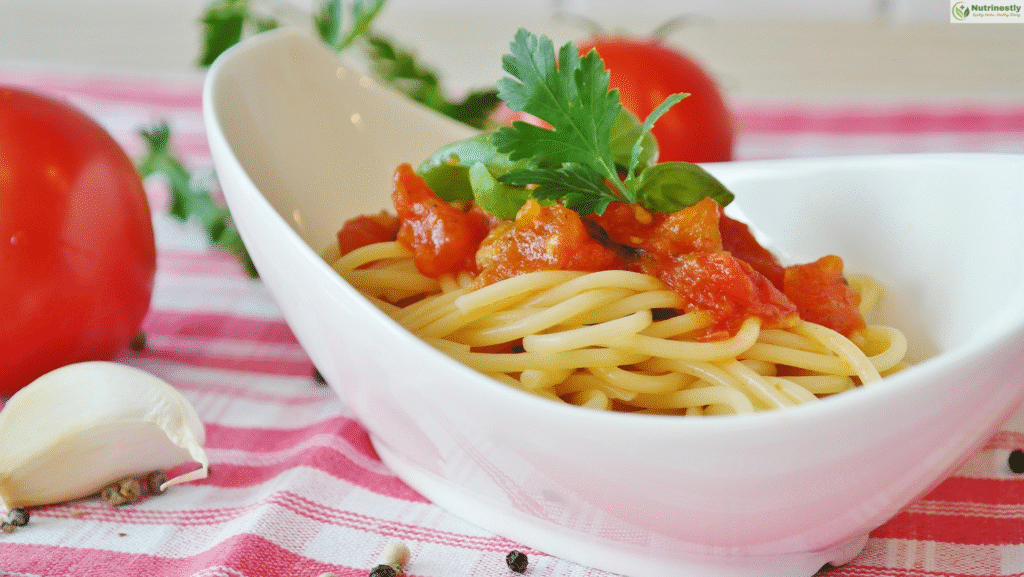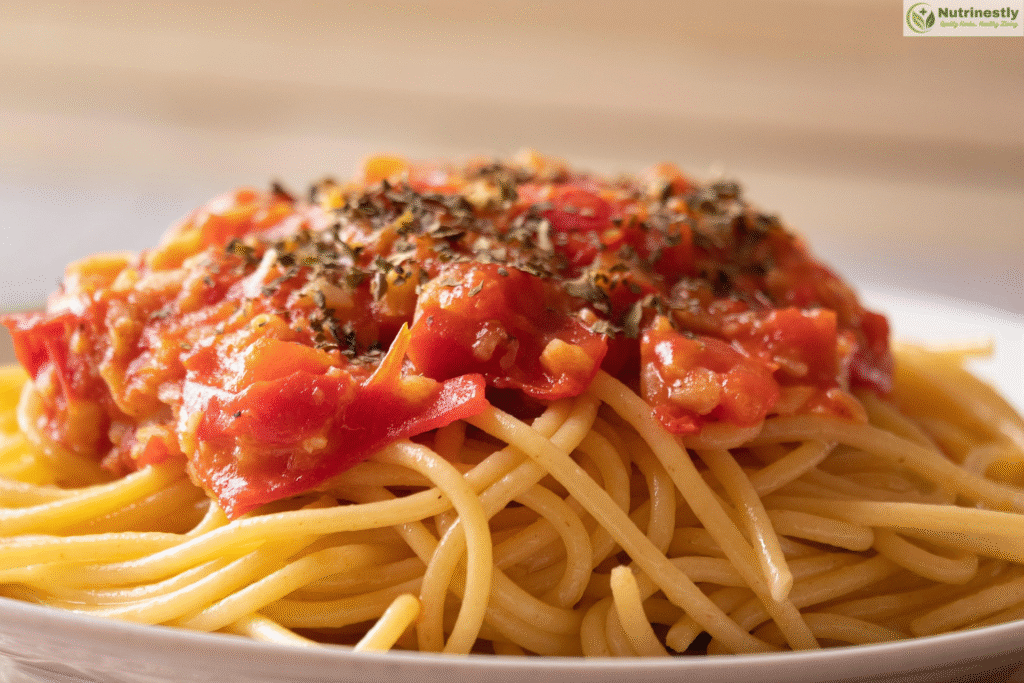
Spaghetti is a universal favorite in most cuisines across the globe due to its diversity and soothing flavor. Yet, with the rising consciousness regarding healthy eating, everyone wonders whether spaghetti has a place in a healthy diet. This in-depth guide delves into the health factors surrounding spaghetti, its nutritional value, advantages, and drawbacks, along with suggestions on how to incorporate it into your meals as a healthy addition.
Understanding Spaghetti: Types and Nutritional Profiles
1. Traditional Refined Spaghetti
Original spaghetti is usually produced with refined wheat flour, which means the bran and germ are taken out during processing. This leads to a smoother texture but also removes vital nutrients.
Nutritional Highlights (per 1 cup cooked):
- B Vitamins: Enriched with thiamin, riboflavin, niacin, and folic acid
- Calories: ~220
- Carbohydrates: ~43g
- Protein: ~8g
- Fiber: ~2.5g
- Iron: ~10% of the Recommended Daily Intake (RDI)
Although refined spaghetti offers energy and some necessary nutrients, its lower fiber content might result in faster digestion and reduced satiety.
2. Whole-Wheat Spaghetti
Whole-wheat spaghetti contains all components of the grain, including the bran, germ, and endosperm, and thus is denser in nutrients and fiber.
Nutritional Highlights (per 1 cup cooked):
- Calories: ~174
- Carbohydrates: ~37g
- Protein: ~7.5g
- Fiber: ~6g
- Manganese: ~97% of RDI
- Selenium: ~52% of RDI
Magnesium, Phosphorus, Copper: Increased amounts compared to refined pasta
The increased fiber content of whole-wheat spaghetti helps with digestion and gives a fuller feeling, which can assist in weight management.
3. Legume-Based Spaghetti (Chickpea, Lentil, Edamame)
Legume-based spaghetti is picking up traction, particularly among those looking for gluten-free or higher-protein alternatives.
Nutritional Highlights (per 2 oz serving):
- Protein: ~12-15g
- Fiber: ~8-12g
- Iron: ~20% of RDI
- Gluten-Free: Good for those who have gluten sensitivities
These alternatives offer a substantial protein and fiber boost, contributing to prolonged satiety and muscle maintenance.
Health Benefits of Spaghetti

1. Energy Provision
It is a significant source of complex carbohydrates, which are the body’s primary energy source. Consuming spaghetti can provide sustained energy, making it an excellent choice for active individuals and athletes.
2. Digestive Health
Whole-wheat and legume-based spaghetti varieties are high in dietary fiber, which promotes healthy digestion
- Preventing constipation
- Maintaining bowel regularity
- Supporting a healthy gut microbiome
3. Heart Health
The fiber in whole-grain spaghetti can contribute to lowering cholesterol levels, thereby decreasing the risk of heart disease. In addition, nutrients such as magnesium and selenium aid in cardiovascular health.
4. Weight Management
High-fiber spaghetti alternatives enhance satiety, which can assist in appetite control and overall caloric reduction. This makes them ideal for weight management programs.
5. Nutrient Density
Spaghetti, particularly whole-wheat and legume-based spaghetti, contains essential nutrients, such as:
- B Vitamins: Essential for energy metabolism
- Iron: Essential for transporting oxygen in the blood
- Magnesium and Phosphorus: Essential for bone health
Potential Drawbacks and Considerations: What to Look Out For When Consuming Spaghetti
While spaghetti can be a healthy component of your diet, particularly if it is prepared from whole grains or legumes, there are a number of important points to bear in mind. Portion control, preparation methods, and serving suggestions can make or break the healthiness of spaghetti.
1. Portion Control: Managing Calories and Carbs
Spaghetti, particularly the refined variety, is calorie-dense and high in carbohydrates. A standard restaurant serving can easily exceed 2 cups of cooked pasta, totaling over 400 calories and 80 grams of carbohydrates before you even add sauce, cheese, or sides.
Why It Matters:
- Overeating risk: Large portions can lead to weight gain, insulin spikes, and energy crashes.
- Glycemic impact: Refined pasta has a higher glycemic index (GI), potentially causing a rapid increase in blood sugar.
- Underestimated serving sizes: One serving of cooked pasta is about 1 cup (roughly the size of a tennis ball), but most people unknowingly double or triple that on their plates.
Smart Tips:
- Measure dry spaghetti (about 2 oz per person) before cooking.
- Use smaller plates or bowls to visually control portions.
- Pair spaghetti with a side salad or grilled vegetables to create a more balanced, filling meal.
2. Sauce Selection: The Hidden Calorie Trap
Spaghetti alone is fairly low in calories and fat. The true nutritional effect too often comes from the sauces and toppings we add.
High-Risk Sauces:
Cream-based sauces such as Alfredo or carbonara: These add 400–600 extra calories per serving, primarily from saturated fats.
Commercial sauces: Most have added sugars, high sodium content, and preservatives.
Saucy meals with beef or pork that are high in fat can increase cholesterol and saturated fat consumption.
Healthier Alternatives:
- Tomato-based sauces (such as marinara or arrabbiata): High in lycopene (a potent antioxidant), low in fat.
- Vegetable-packed sauces: Prepared with mushrooms, zucchini, bell peppers, spinach, or eggplant for an extra dose of fiber and nutrients.
- Homemade pesto with olive oil, basil, garlic, and pine nuts or walnuts can be a healthy, heart-healthy, and tasty option when used in moderation.
3. Gluten Sensitivity and Digestive Discomfort
For most, gluten, a protein in wheat, is not harmful. But in some, it can cause significant health problems.
Who Needs to Be Careful:
Those with celiac disease: Even small amounts of gluten initiate autoimmune responses that harm the small intestine.
Those with non-celiac gluten sensitivity (NCGS): They might have bloating, fatigue, brain fog, and joint pain following the consumption of gluten-containing foods.
IBS patients: Some experience worsening symptoms after consuming gluten-containing pasta.
Gluten-Free Choices:
- Brown rice pasta: Mild-tasting, moderate fiber, and gluten-free.
- Legume-based pasta (lentil, chickpea, edamame): More protein and fiber, naturally gluten-free.
- Quinoa pasta: Nutrient-rich and gluten-free, with a slightly nutty taste.
4. Refined Pasta and Blood Sugar: A Concern for Diabetics
Refined pasta triggers sudden blood sugar spikes, particularly in people with insulin resistance or type 2 diabetes.
Why It Happens:
- The germ and bran are removed during refining, which decreases fiber intake.
- Low fiber results in faster digestion and absorption of glucose.
What to Do:
- Select whole-grain or high-fiber pasta with a lower glycemic load.
- Pair pasta with healthy fat and lean protein (such as olive oil or broiled salmon) to slow down digestion.
- Check blood sugar after meals to determine personal response.
5. Sodium and Preservatives in Pre-Packaged Meals
Pre-cooked spaghetti dinners, frozen dinners, or canned spaghetti tend to be high in sodium and preservatives.
Health Hazards:
- Excessive sodium consumption is associated with hypertension, kidney stress, and augmented cardiovascular risk.
- Artificial ingredients (e.g., monosodium glutamate, high-fructose corn syrup) may lead to inflammation or sensitivity reactions in certain people.
Healthier Approach:
- Prepare pasta meals from raw, whole ingredients.
- Scan nutrition labels on packaged meals and sauces Choose products with fewer than 300 mg of sodium per serving.
6. Nutrient Imbalance in a Pasta-Dominant Meal
If spaghetti is the main event on the plate without enough support from other food groups, the meal may be missing key nutrients like
- Vitamin C and antioxidants from vegetables
- Calcium and omega-3s from dairy or fish
- Healthy fats from oils, nuts, or seeds
Repair the Imbalance:
- Spaghetti as a base, not the entire meal.
- Pair pasta always with vegetables, a lean protein, and a healthy fat for an overall macro- and micronutrient composition.
Summary Table: Common Pitfalls vs. Healthy Pasta Habits
| Potential Drawback | Healthier Alternative |
| Overeating large portions | Stick to 1 cup cooked; bulk with veggies |
| High-fat, creamy sauces | Use tomato-based or veggie-rich sauces |
| Refined pasta only | Choose whole-grain or legume-based pasta |
| Gluten issues | Switch to gluten-free options (e.g., chickpea pasta) |
| Pre-packaged pasta meals | Cook at home; read nutrition labels carefully |
| Unbalanced meal (just pasta) | Add vegetables, lean protein, and healthy fats |
Tips for Making Spaghetti a Healthy Meal

- Choose whole-grain or legume-based varieties: these options offer more fiber and nutrients.
- Incorporate Vegetables: Adding a variety of vegetables increases fiber and vitamin content.
- Add Lean Proteins: Including sources like grilled chicken, tofu, or legumes can make the meal more balanced.
- Mind the Sauce: Prepare sauces at home using fresh ingredients to control added sugars and fats.
- Watch Portion Sizes: Stick to recommended serving sizes to avoid overeating
Final Result
Spaghetti can be a wholesome part of your nutrition if selected and prepared with care. Selecting whole-grain or legume types, adding vegetables in abundance, and watching portion sizes and ingredients in the sauce can turn spaghetti into a healthful and wholesome dish. In moderation and balance, as in all foods, spaghetti can be a part of healthy living

